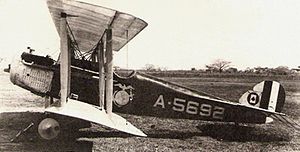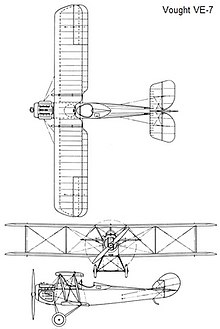Vought VE-7
| Vought VE-7 Bluebird | |
|---|---|

|
|
| Type: | Training and fighter aircraft |
| Design country: | |
| Manufacturer: | |
| First flight: |
1917 |
| Commissioning: |
1918 |
| Production time: |
1918 to 1928 |
| Number of pieces: |
128 |
The Vought VE-7 Bluebird was an early two-seater American biplane from 1917 and initially served as a training aircraft . The VE-7 later became the first American fighter in the US Navy to take off from an aircraft carrier in 1922 .
history

The Lewis & Vought Company was founded on June 1, 1917. The VE-7 was designed based on successful European aircraft designs. The engine was a 180-hp Wright-Hispano-Suiza E3, as it was also used by the French Spad . In practice, the performance of the VE-7 was much higher than actually necessary for training aircraft and was comparable to that of the best fighter aircraft. The first pre-production copies of the VE-7 were delivered to the US Army in the spring of 1918 . The US Army ordered 1000 machines of the extended variant VE-8 . However, this order was terminated at the end of the war .
The VE-7 had at least aroused interest from the US Navy , so it got its first machine in May 1920. Series production took place shortly afterwards. This order was too big for Vought and so the Naval Aircraft Factory also made machines. A total of 128 VE-7s were built.
The fighter version was called the VE-7S and was a single-seater with a propeller-synchronized Vickers 7.62mm machine gun . Some VE-7SF machines had inflatable floats designed to keep the aircraft afloat in the event of a ditching .
The VE-7 machines were assigned to the naval fighter squadrons VF-1 and VF-2 . On October 17, 1922, Lieutenant Virgil C. Griffin made the first take-off from the deck of the new aircraft carrier USS Langley . The last three machines were not withdrawn from Langley until 1927 and finally retired in 1928. An improved variant of the VE-7/9 was the UO-1 developed in 1922 .
Technical specifications
| Parameter | Data |
|---|---|
| crew | 2 |
| length | 7.40 m |
| span | 10.3 m |
| height | 2.6 m |
| Wing area | 26.43 m² |
| Empty mass | 683 kg |
| Takeoff mass | 986 kg |
| drive | a Wright-Hispano-Suiza E3 radial engine with 180 PS (132 kW) |
| Top speed | 191 km / h |
| Service ceiling | 5891 m |
| Range | 470 km |
| Armament | a MG Vickers caliber 0.30 (7.62 mm) |
literature
- Peter M. Bowers : United States Navy Aircraft since 1911. Naval Institute Press, Annapolis (Maryland) 1990, ISBN 0-87021-792-5 , pp. 428-431.
- Lloyd S. Jones: US Naval Fighters. Aero Publishers, Fallbrook (California, USA) 1977, ISBN 0-8168-9254-7 , pp. 11-13.

